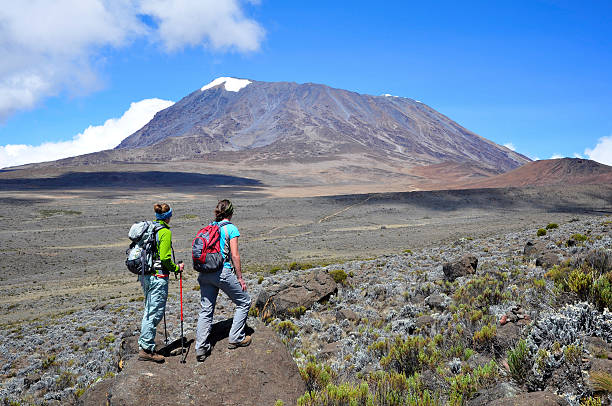Mount Kilimanjaro Trekking Guide
Mount Kilimanjaro, standing tall at 5,895 meters (19,341 feet), is the highest mountain in Africa and the tallest free-standing mountain in the world. Located in northeastern Tanzania, Kilimanjaro is one of the world’s most iconic trekking destinations—offering a non-technical but physically demanding challenge that attracts thousands of adventurers each year.
🏔 Overview of Mount Kilimanjaro
- Location: Tanzania, East Africa
- Elevation: 5,895 m (19,341 ft)
- Best Time to Trek: January–March and June–October
🗺 Kilimanjaro Routes: Which One to Choose?
1. Marangu Route (5-6 days)
- Nicknamed: "Coca-Cola Route"
- Pros: Cheaper, easier logistics
- Cons: Lower success rate due to rapid ascent
2. Machame Route (6-7 days)
- Nicknamed: "Whiskey Route"
- Pros: Good acclimatization profile
- Cons: Steeper and more physically demanding
3. Lemosho Route (7-8 days)
- Pros: High success rate, great acclimatization
- Cons: More expensive due to duration and logistics
4. Rongai Route (6-7 days)
- Pros: Less crowded, good during rainy season
- Cons: Less varied scenery
5. Northern Circuit (9+ days)
- Pros: Highest success rate, excellent acclimatization
- Cons: Expensive, requires more time
🧭 Choosing a Tour Operator
- Certified and experienced guides
- Good staff-to-client ratio
- Transparent pricing (watch for hidden fees)
- Emergency protocols and equipment
- Positive reviews and safety record
🏕 What to Expect on the Trek
Daily Routine
- Wake up: 6–7 AM
- Trekking: 4–8 hours per day
- Summit day: 12–16 hours
Summit Day
Begins around midnight, reaches Uhuru Peak at sunrise. It's the most challenging day with a steep descent afterward.
🧳 Packing List
Clothing
- Thermal base layers
- Insulating layer (fleece/down)
- Waterproof jacket and pants
- Warm hat, gloves, and gaiter
Footwear
- Broken-in hiking boots
- Warm socks (wool)
- Camp shoes
Gear
- Daypack (30–40L)
- Sleeping bag (-10°C or lower)
- Trekking poles, headlamp
- Water bottles/hydration system
🧠 Altitude Sickness and Acclimatization
Symptoms
- Headache
- Nausea
- Dizziness
- Fatigue
Prevention
- Ascend slowly
- Stay hydrated
- Consider Diamox
💰 Costs and Budgeting
- Average total cost: $1,500–$5,000+
- Included: park fees, meals, guides, logistics
- Extras: tips, gear rental, travel insurance
📅 When to Go
- Best: January–March, June–October
- Avoid: April–May (long rains), November (short rains)
🌍 Cultural and Environmental Considerations
- Support ethical trekking operators
- Leave no trace
- Respect porters and local customs
✅ Final Tips
- Train before your trek
- Stay in Moshi or Arusha pre-trek
- Get travel insurance covering altitude
- Enjoy the journey!
❓ Frequently Asked Questions (FAQs)
1. Do I need to be super fit to climb Kilimanjaro?
Not super fit, but you need good endurance and cardio conditioning. Regular trekking, cardio workouts, and hill training are recommended.
2. How cold does it get on Kilimanjaro?
It can reach as low as -20°C (-4°F) near the summit, especially during the night and early morning hours on summit day.
3. What is the summit success rate?
Success rates range from 65% on shorter routes to 95% on longer, well-acclimatized treks like the Northern Circuit.
4. How long does it take?
Most routes take between 5 to 10 days to complete, depending on the route and your acclimatization strategy.
5. Is altitude sickness common?
Yes. Most trekkers experience mild symptoms, but serious altitude sickness can be avoided by ascending slowly and hydrating well.
6. Can I climb without a guide?
No. Kilimanjaro can only be climbed with a licensed guide and registered tour operator, as required by Tanzanian law.
7. What is the food like?
Most operators provide hot, freshly cooked meals including rice, pasta, soups, vegetables, and meat. Dietary preferences are usually accommodated if notified in advance.
8. Where do I sleep?
You will sleep in tents provided by the tour operator, except on the Marangu route, which has shared hut accommodations.
9. Are there toilets?
Public camps have basic toilets, but many operators offer private portable toilet tents for added comfort.
10. What’s the tipping etiquette?
It’s customary to tip your trekking crew. Budget around $250–$300 USD per trekker for the entire team, split among guides, cooks, and porters.
11. Is there Wi-Fi or cell signal?
Cell signal is intermittent and unreliable. You may get signal at certain points, but it's best to plan to be offline for the duration of the trek.
12. What documents do I need?
You’ll need a valid passport, Tanzanian tourist visa (available online or on arrival for many nationalities), and a yellow fever certificate if you're arriving from a risk country.
13. Do I need vaccines or malaria pills?
Vaccinations like Hepatitis A/B, Typhoid, and Tetanus are recommended. Malaria prophylaxis is advised, especially if you’ll be in lowland areas before or after the trek.
14. Is it safe?
Yes, Kilimanjaro is generally safe when climbed with a reputable operator. Guides are trained to monitor your health and respond to emergencies.
